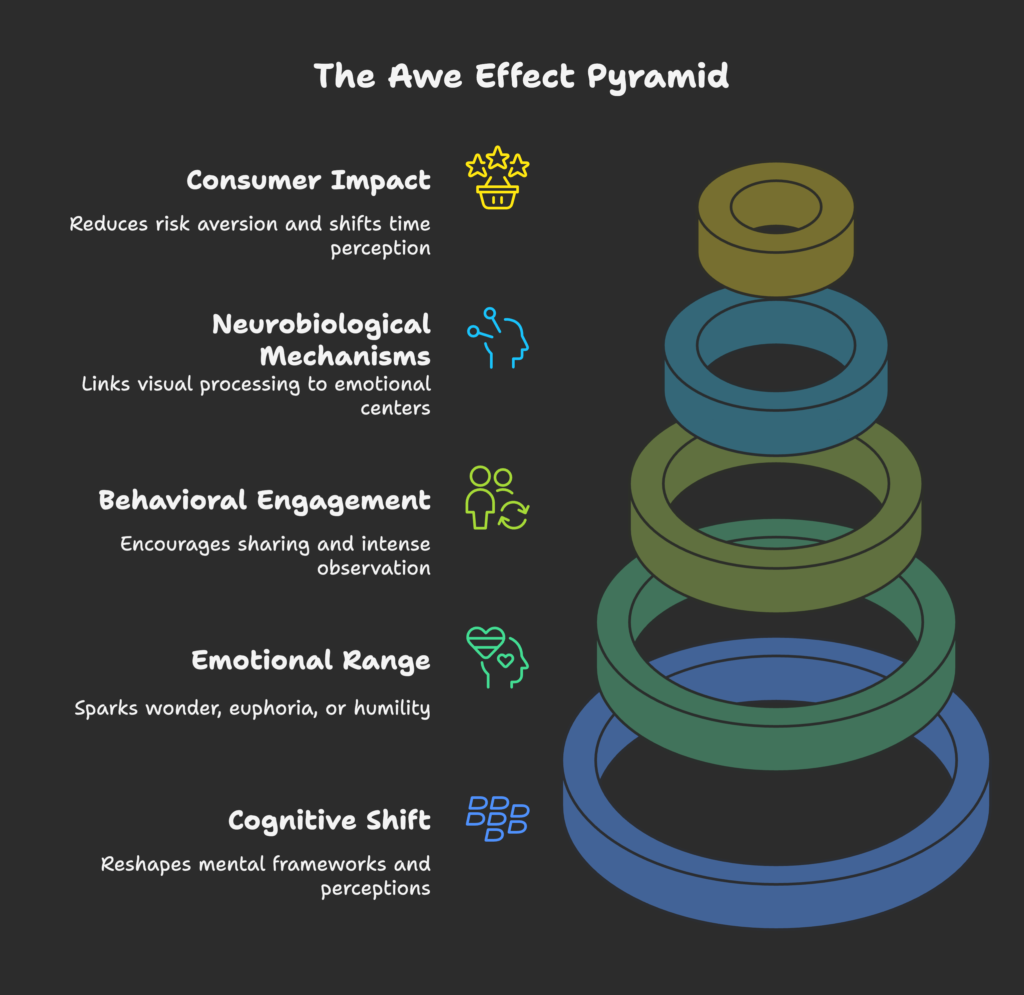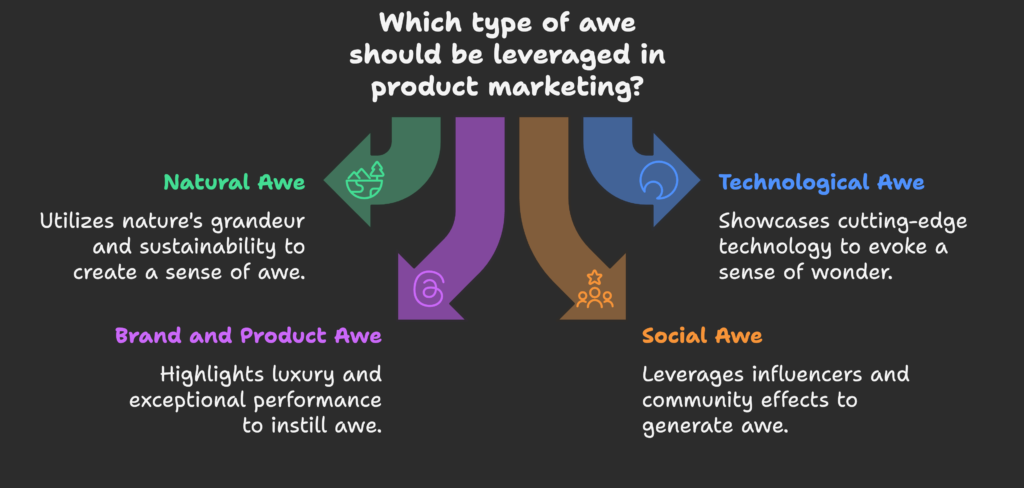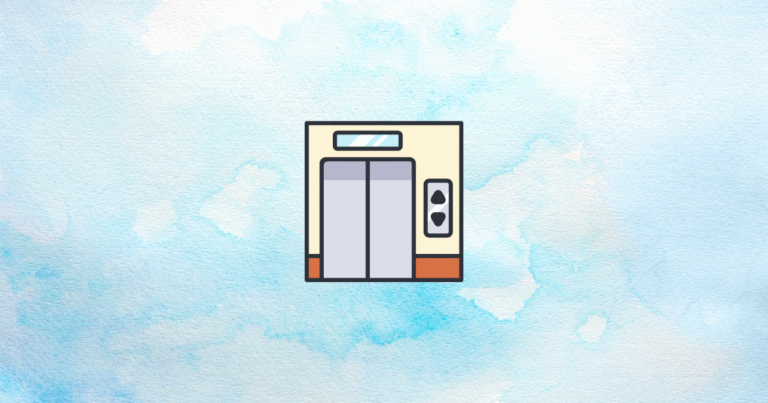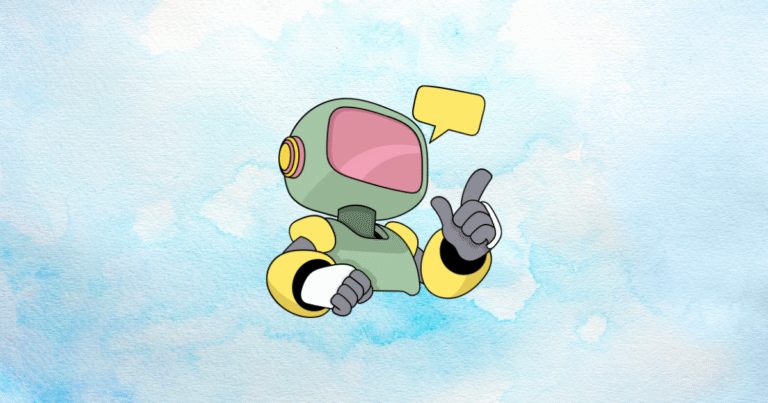Have you ever been instantly speechless by a breathtaking mountain view or felt goosebumps while watching a dazzling product unveiling? That feeling is *awe* — a powerful emotional response that makes us step back and think, “Wow!” In marketing, harnessing this wonder can be a game-changer. By reading on, you’ll see why *awe* not only captivates audiences but also boosts conversions and brand loyalty. Ready to spark a little wonder in your customers? Let’s begin!
In this section: We’ll define awe, look at how it differs from emotions like delight or satisfaction, and explore why it’s such a potent tool in today’s attention-starved market. You’ll discover how a “jaw-dropping” effect can move customers from casual curiosity to enthusiastic commitment.
Defining Awe in Consumer Contexts
Awe is commonly described as an emotional blend of *vastness* (perceiving something grander or more amazing than expected) and *accommodation* (the mind expanding its mental “map” to understand new stimuli). It’s more than simple surprise or delight. Instead, it triggers a sense of wonder or reverence. In marketing, showcasing a product in a truly impressive way—whether by magnitude, novelty, or emotional resonance—can evoke awe. Research highlights that *awe experiences* stick in our memories and create stronger emotional ties to brands or services.
The Evolution of Awe in Marketing Strategy
Awe-based marketing isn’t new. Classic TV ads once featured epic visuals—exotic vistas, grand sets—to amaze viewers. Now, with digital advancements, brands can produce *immersive experiences* (like 360° product tours or interactive events) that amplify awe beyond passive watching. Current trends involve using VR or AR to magnify the “wow factor,” while brand influencers push stunning visuals on social media to create a sense of wonder among followers. As consumer attention fragments, *awe* stands out as a surefire way to grab it.
The Business Case for Awe-Based Marketing
- Capturing Attention: In a crowded digital world, an awe-inspiring demonstration cuts through the noise.
- Brand Differentiation: When competitors rely on standard product listings, an awe moment sets you apart as bold and memorable.
- Conversion Influence: Customers touched by awe can feel more open to buying or sharing the experience, boosting sales and referrals.
- Long-Term Loyalty: Emotional memories of an awe moment can bond customers to a brand, leading to repeat engagement.
Now let’s explore what happens psychologically and neurologically when we experience awe. You’ll see how this emotion shapes decision-making, memory, and brand perception.
Psychological and Neurological Foundations of Awe
In this section: We’ll uncover the emotional blend that forms awe, how the brain processes “vastness” or “wow factor,” and why it affects consumers’ willingness to explore or purchase.

The Psychological Components of Awe
- Cognitive: Awe forces our brains to reshape mental frameworks. We may think, “I’ve never seen anything like this before,” leading us to reinterpret the product or brand as extraordinary.
- Emotional: Feelings range from wonder and euphoria to a sense of humility or insignificance. This emotional range can spark approach (excitement) or mild avoidance (overwhelmed).
- Behavioral: People often pause, observe intently, or share the experience with others. This can translate into brand engagement or immediate social media posting.
Core to awe is that self-transcendence moment—customers might see themselves and the brand as part of something bigger.
Neurobiological Mechanisms
Scientifically, awe involves *visual processing centers* linking to emotional regions like the amygdala, producing strong emotional weight. Dopamine, oxytocin, and serotonin may rise, reinforcing positive association with the brand. Meanwhile, memory centers work overtime—**awe** experiences are more likely to stick, fueling recall and repeat purchases. Overall, awe bypasses mundane “comparison shopping” logic in favor of a big emotional “wow.”
Awe’s Impact on Consumer Decision-Making
- Reduced Risk Aversion: Customers in awe states might find the purchase risk less intimidating, deciding, “This is amazing; I want in!”
- Time Perception Shift: Awe can make time feel abundant, leading people to linger over product details or brand stories, thus higher engagement.
- Price Sensitivity: When enthralled, some consumers pay less attention to cost or are more forgiving of premium pricing, trusting the brand’s perceived value.
But how does awe translate into actual marketing content? Let’s look at different “types” of awe that can fit seamlessly into your brand’s demonstrations or product shots.
Types of Awe in Product Marketing Contexts
In this section: We’ll spotlight how brands harness nature, technology, brand heritage, or social influences to spark “wow!” moments. Each route triggers a slightly different flavor of awe.

Natural Awe
- Nature Themes: Using majestic landscapes or swirling, vivid visuals for backgrounds. Car commercials often do this, placing vehicles against imposing mountains or oceans to create an epic vibe.
- Environmental Angles: Linking product stories to sustainability or nature conservation, letting customers sense a bigger cause, intensifying awe.
- Case Studies: Outdoor brands effectively rely on breathtaking shots of athletes on huge cliffs or forest trails. The sublimity of nature becomes attached to the product.
Technological Awe
Some brands show off *cutting-edge technology* that seems almost magical—like flexible screens or AI-powered features. This “future is now” feeling can enthrall viewers. VR or AR product demonstrations let users see extraordinary capabilities in real time. The unveiling moment, reminiscent of big tech keynotes, is designed to shock and delight. For instance, Apple’s product keynotes famously revolve around a big “wow factor” demonstration that leaves the audience buzzing with excitement.
Brand and Product Awe
- Luxury and Premium Brands: Rolls-Royce or Rolex rely on craftsmanship stories—rare materials, thousands of hours invested, near-mythical production details—to instill awe at the brand’s perfection.
- Performance Surprises: Show the product exceeding typical expectations (like an SUV climbing impossible terrains). That “didn’t know it could do that” triggers awe-based excitement.
By contrasting the product’s *wild capabilities* with normal expectations, brands create a sense that “this is no ordinary item.”
Social Awe
Influencers and celebrities sometimes carry an “awe factor,” transferring their star power onto products. The notion of *community awe* also arises when large crowds or group achievements produce a sense of scale or synergy. Limited-edition collaborations gather hype from a social vantage: fans see massive interest and are awed by the brand’s cultural impact, driving them to buy. “If everyone’s in awe, I should be, too!”
We’ve identified ways to evoke awe thematically. Next, we’ll detail how to implement those ideas in practical product demonstrations—covering visuals, narratives, and even interactive elements.
Implementing Awe in Product Demonstrations
In this section: We’ll outline design principles for visuals, structure for the storyline, and methods to involve the audience so that your brand’s demonstration resonates deeply in that short “wow!” window.
Visual Design Principles for Awe
- Scale & Proportion: Emphasize size contrasts (like a small user amidst giant displays) or show massive visuals. This underscores a sense of grandeur.
- Color Use: Vibrant, contrasting palettes can pop, while black-and-white designs with a single bold accent highlight details that stun viewers.
- Dynamic Elements: Movement—like swirling animations or pivoting cameras—enhances the sense of wonder. Still images can be overshadowed if the brand next door is swirling and shining.
Narrative Structure of Awe-Inducing Demonstrations
People love a *story* that builds tension. Awe moments typically come from:
- Anticipation: Tease the highlight. “Something big is coming…”
- The Reveal: A sudden unveiling or big reveal that’s bigger or more beautiful than expected, hooking emotional responses.
- Resolution: Integrate a call-to-action so viewers’ excitement channels into immediate sign-up or purchase.
A carefully timed demonstration that escalates to a grand surprise tends to lodge in memory (and social media shares) long after the event ends.
Multisensory Enhancement Strategies
- Audio Cues: Epic orchestral swells or dramatic stings can amplify the sense of scale. Even subtle chimes at key moments can highlight big product feats.
- Tactile Elements (In-Person): If physically demoing, let attendees handle or experiment with the product. The “touch” dimension can seal their impression of quality or complexity.
- Environmental Control: Adjust lighting, temperature, or even mild fragrances to reinforce the mood. Ambience is your ally!
Interactive and Participatory Elements
Surprises get bigger when the audience is involved:
- Hands-On Trials: Let potential buyers themselves trigger the product’s impressive effect. They’ll feel they “made” something amazing happen.
- Shared Moments: A group seeing something simultaneously fosters collective awe. This synergy often boosts social media hype: everyone wants to share the jaw-dropping experience.
- Personalization: Let the demonstration adapt to each viewer, giving them a sense of controlling or co-creating the big reveal, fueling deeper emotional buy-in.
Next, we’ll consider how these principles adapt for purely digital imagery or physical store installations, ensuring your brand message never loses that “wow factor.”
Awe in Digital and Physical Product Imagery
In this section: We’ll distinguish how to capture awe in 2D digital settings (like websites, social ads) vs. real-world environments (stores, events). We’ll also see how bridging them yields consistent awe across channels.
Digital Imagery Techniques
- High-Definition Visuals: Crisp, cinematic close-ups or dramatic angles can instill a sense of grand reveal. Coupled with carefully chosen music or transitions, a product can appear almost mythical.
- 3D and Motion Graphics: Animations that rotate or explode the product into layered visuals create mesmerizing displays. Think rotating smartphone reveals, or stylized transitions showing how each component unites.
- User Interface Design: For purely digital products (apps, software), a visually captivating UI with smooth transitions or animations can wow new users as soon as they open it.
Physical Display and Demonstration Environments
*Retailers* might design “experience corners” with carefully tuned lighting or dynamic screens. Minimal, strategic product placement can highlight the product’s “specialness.” *Exhibitions* and trade shows can incorporate dramatic unveiling—raising a curtain or using lasers to show scale. Meanwhile, staff themselves can be part of it: trained to present the product with enthusiastic flair, reinforcing that sense of “you have to see this!”
Cross-Platform Integration
- Consistent Awe Across Touchpoints: If your Instagram content is jaw-dropping, but your website is bland, you break the sense of wonder. Keep the theme cohesive.
- Physical to Digital Transitions: Encourage live attendees to share experiences or scan a code to find an AR reveal at home—maintaining momentum after they leave the physical site.
- Social Media Amplification: The best awe experiences go viral. Encourage user-generated content. Let them post that goosebump moment or surprising new feature demonstration as a personal endorsement.
But how do we measure awe’s success? Let’s see how to track direct conversions, brand engagement, or emotional responses, and compare them to standard marketing campaigns.
Measuring the Effectiveness of Awe
In this section: We’ll detail how you can gather data (from neuroscience tools to standard web analytics) to verify that awe-based strategies pay off, while also capturing the intangible brand-lift benefits over time.
Quantitative Assessment Methods
- Neurophysiological Metrics: In advanced studies, EEG or biometric data (heart rate, pupil dilation) can detect that *wow* spike. Harder to implement but very telling.
- Conversion & Sales: Compare online purchase or sign-up rates for “awe-themed campaigns” vs. typical promotions. A clear lift signals success.
- Engagement & Retention: Track social share counts, time on site, or repeated product usage. Awe can encourage deeper, more devoted exploration.
Qualitative Evaluation Approaches
Sometimes, you need direct feedback to gauge awe. *Interviews* or *focus groups* can reveal if participants truly felt that sense of breathless wonder. You can also do observational studies at events—does the crowd gasp? Are they enthralled by the demonstration? *Sentiment analysis* on social media or user forums can also show if people used words like “amazing,” “wow,” or “incredible.” Meanwhile, tracking brand mentions post-campaign reveals lasting impressions.
ROI Measurement Frameworks
- Cost-Effectiveness: Awe campaigns may require bigger budgets for production or technology. Ensure you measure the incremental revenue or brand equity to see if it’s justified.
- Short-Term vs. Long-Term: Some “wow moments” might produce immediate hype. Others yield brand loyalty for months or years. Distinguish both time frames in your analysis.
- Competitive Advantage: If your nearest competitors aren’t eliciting awe, your unique angle might yield intangible brand goodwill, making you a top-of-mind choice down the road.
Now, let’s witness how real brands have wielded the power of awe—what they did, how it resonated, and the results they reaped.
Case Studies and Success Stories
In this section: We’ll highlight awe-based strategies that propelled luxury brands, mainstream consumer products, and even performing arts into marketing success. This includes real data on conversions or brand halo effects.
Luxury Brand Applications
- Premium Automotive Unveilings: Brands like Tesla and Rolls-Royce introduced new models with dramatic stage events—huge LED backdrops, choreographed reveals. Result: immediate pre-orders soared.
- High-End Electronics: Some phones or wearables get showcased in massive auditorium demos with interactive floors or grand VR experiences, fueling headlines and social media buzz.
- Luxury Fashion & Accessories: Runway shows with stunning backdrops or swirling visuals create a sense of *exclusivity + wonder*. This intangible aura helps sell items at premium prices.
Mass Market Implementations
- Consumer Electronics: LG or Samsung occasionally deploy immersive arcs or giant installations at trade shows, letting visitors feel dwarfed by scale to get them excited about new screens or features.
- Food & Beverage: Staged “food theater” demonstrations—like flambé cooking or color-changing cocktails—prompt on-the-spot sales. Awe triggers the “I want that experience at home.”
- Home Products Transformations: TV shows or live events that do *extreme makeovers* of a space can awe the audience, raising brand desire for the showcased hardware or decor.
Cirque du Soleil’s “Science of Awe”
This famous performance group merges breathtaking feats of acrobatics with emotive storylines. Research cited in their “Science of Awe” initiative showed audiences felt deeper brand loyalty and recommended Cirque experiences to friends after witnessing the show’s captivating artistry. This approach underlines how *performing arts awe* can be mapped into marketing – telling a brand story with big visual impact can yield similarly strong emotional ties and word-of-mouth marketing.
But watch out for ethical hazards – overpromising or artificially pumping up illusions can lead to brand distrust. Next, we’ll ensure you harness awe responsibly while respecting cultural differences and user well-being.
Ethical Considerations and Limitations
In this section: We’ll check the potential pitfalls of using awe – from authenticity issues to potential cultural insensitivity – and how to keep building wonder without crossing lines.
Authenticity vs. Manipulation
- Genuine Product Capabilities: Awe works best when your product truly impresses. If the experience is all hype and zero substance, you risk customer disappointment or backlash.
- Honest Representation: Overly edited images or illusions can become manipulative if the actual item falls flat in real life. Transparency fosters trust even amidst the wow factor.
- Long-Term Relationships: Overblown spectacle may spike immediate sales but harm brand reputation if people feel tricked. Real awe should be backed by real value.
Cultural and Individual Differences
- Cultural Sensitivity: Something that wows a Western audience might appear mundane in Asia or vice versa. Understand local icons of wonder.
- Accessibility: Some “epic” experiences can exclude those with sensory or mobility challenges. Consider inclusive design that offers awe for all, not just physically present or able-bodied attendees.
Tailoring your approach ensures you spark positive awe, not confusion or a sense of irrelevance among certain demographic groups.
Psychological Impact Considerations
- Desensitization: Repeatedly using superlatives or epic stunts can diminish the novelty, requiring ever more extreme marketing to stand out.
- Boundary of Consent: Overwhelming experiences (e.g., extremely loud or emotionally intense displays) might cross personal comfort zones.
- Long-Term Behavior Shifts: Awe can create deep loyalty or impetus to buy, but if overused, can cause emotional fatigue. Balanced usage is key.
We’ve covered the possible downsides. Let’s see where the future stands: AI, XR, and personalization might shape the next wave of jaw-dropping brand experiences.
Future Directions and Innovations
In this section: We’ll reveal how advanced tools and cross-disciplinary methods will push awe-based marketing forward, from real-time personalization with AI to next-level VR illusions.
Technological Advancements
- Extended Reality (XR): Merging AR/VR means consumers can watch a physically small item transform into an enormous 3D display, intensifying awe’s sense of scale.
- AI Personalization: Automated “wow triggers” could adapt the demonstration to each user’s profile. The system might show advanced features to a tech-savvy person, or emotional user stories to a more sentimental buyer.
- Sensory Augmentation: Next-level haptics or interactive installations let people “feel” the experience, adding extra layers of immersion.
Cross-Disciplinary Approaches
- Neuroscience Integration: Brain-scan data might reveal the best ways to time or structure reveals, maximizing emotional peaks in a demonstration.
- Theatrical & Cinematic Techniques: Directors or choreographers from entertainment could partner with brands to stage truly immersive product shows, bridging the line between commerce and performance art.
- Environmental Psychology: Understanding how space design and lighting produce calm or intense emotional states can refine brand events to produce consistent, high-impact awe.
Emerging Research and Applications
Awe might move beyond pure marketing to shape *sustainability messaging* (evoking nature’s grandeur to inspire eco-friendly behavior) or *community building* (fostering brand tribes through shared awe experiences). As cultures shift and generational mindsets evolve, new triggers for wonder will appear. Ultimately, “awe marketing” might become standard, with each brand competing to orchestrate the most mesmerizing experiences in increasingly sophisticated ways.
Finally, let’s unify all these insights into a practical guide so you can plan and launch your own awe-based marketing approach—step by step, from concept to measurement.
Implementation Guide for Marketers
In this section: We’ll provide a straightforward roadmap for adopting awe tactics, from initial audits to final deployment and continuous improvement. Time to turn your brand’s product showcases into genuinely awe-inspiring events.
Assessment and Strategy Development
- Evaluate Suitability: Does your product have features or stories that can authentically evoke awe? Or will you rely on creative staging (like nature backdrops or advanced tech illusions)?
- Identify Awe Triggers: Are you highlighting scale, novelty, emotional resonance, or social proof? Pinpoint your “hook” that’s truly extraordinary.
- Research Competitors: Notice who else is using big reveal strategies. Aim to be unique or push the envelope to stand out.
Production and Execution Framework
- Team Skills: For a big reveal event, gather design pros, narrative experts, maybe even stage or VR specialists.
- Technical Requirements: If going digital with 3D or VR, ensure the platform runs smoothly. For physical events, rehearse lighting and audio. Avoid technical hiccups that break the immersion.
- Testing & Refinement: Do a “soft launch” or internal run-through to gauge if people truly feel wowed. Adjust pacing, visuals, or script as needed.
Integration with Broader Marketing Strategy
*Ensure your brand’s entire funnel* aligns with the awe concept:
- Channel Coordination: Teasers on social media, consistent hype on the website, synergy in email campaigns, etc.
- Timing the Impact: Launch big reveals near relevant seasons (holiday, product cycle) to maximize synergy with existing campaigns.
- Measurement & Improvement: Track immediate sales spikes or sign-ups, plus longer-term brand sentiment. Use data to refine your next wave of awe experiences.
Small Note: If you’re a Shopify merchant itching to craft awe-inducing product launches or demonstrations, try the Growth Suite application. It aids in staging mesmerizing reveals, tracking their impact, and integrating them across your store’s sales channels—giving your products the “wow” factor they deserve.
References
- Kamal, A., Mycah, H., Elizabeth, H., & Andrew, P. (2024). The effects of awe‐eliciting experiences on consumers’ aversion to choice ambiguity. Wiley Online Library. Link
- Burson Cohn & Wolfe. (2018). Science of Awe. Ads of the World. Link
- The Media Leader. (2023, October 4). The power of awe. Link
- Intermark Group. (2019, October 31). Using Awe To Engage Consumers (Marketing Strategy). YouTube. Link
- Frontiers. (2023, October 2). Planet earth calling: unveiling the brain’s response to awe. Frontiers in Neuroscience. Link
- PubMed. (2020). Brand awe: A key concept for understanding consumer response to luxury and premium brands. Link
- Qiushi Journal. (2018, May 1). Awe: A Complex Emotion and Its Prospects in the Field of Consumer Behavior. Link
- Semantic Scholar. (2023, May 10). The double-edged sword effect of awe of nature on consumers’ new product choice. Link
- Semantic Scholar. (2025, February 5). Awe and aesthetics: Conundrums of creation and consumption. Link
- AMS Promotions. (2024, October 9). The Power of Product Demonstrations. Link
- The Brand Weaver. (2024, February 16). Provocative Branding: Does Shock and Awe Belong in Marketing? Link




